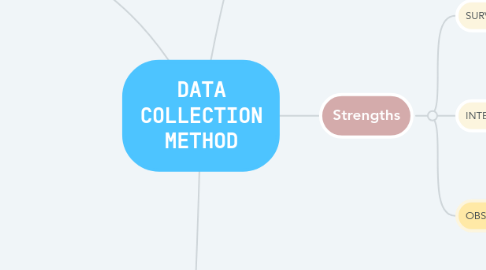
1. Challenges
1.1. Interview
1.1.1. The duration of an interview and the time between interviews.
1.1.2. Time management
1.1.3. The days elapsed between one interview and another, when several meetings with the same person are required.
1.1.4. If the interviewer is inexperienced, the process may be affected.
1.2. Observation
1.2.1. The duration of the observation and the time between the observation.
1.2.2. The sessions are controversial
1.2.3. It is difficult to apply to large groups.
1.2.4. Qualified observers are required.
1.2.5. Unable to obtain past event information.
1.3. Survey
1.3.1. It is impossible to interview
1.3.2. A large number of questionnaires are lost when they are sent through a link and are not answered.
1.3.3. Responses may be affected by the participant's mood or general state.
1.3.4. The responses can be more thoughtful, as time is not required to complete them and as they have greater freedom of expression as the respondent is not coerced by the interviewer's presence.
1.3.5. Answering it involves some level of understanding and expression.
2. Definition
2.1. It is important to define the most appropriate methods for data collection.
2.1.1. INTERVIEW .
2.1.1.1. A very useful technique in qualitative research to collect data.
2.1.1.2. Conversation that has a specific purpose other than the simple fact of conversing.
2.1.1.2.1. It helps the researcher to better understand the context.
2.1.1.2.2. Interviews can be structured, semi-structured or unstructured.
2.1.1.3. A technical instrument that takes the form of a colloquial dialogue.
2.1.2. OBSERVATION
2.1.2.1. A method that allows individuals to collect information about others.
2.1.2.1.1. by observing their actions and behaviors in their natural environment.
2.1.2.2. Direct observation implies that the researcher observes interactions.
2.1.2.2.1. The analysis can be covert or overt.
2.1.2.3. The researcher not only observes, but also participates in activities
2.1.3. SURVEY
2.1.3.1. It is used to collect information through a questionnaire.
2.1.3.1.1. It consists of asking one or several people their opinion on a subject.
2.1.3.2. Interviews are qualitative in nature and therefore focus on personal experience.
2.1.3.3. If closed questions are used, the Likert scale can be applied to measure standard responses.
2.1.3.3.1. Open-ended questions provide more complete, comprehensive and meaningful data.
3. MAIN CHARACTERISTICS
3.1. INTERVIEWING
3.1.1. Help to the researcher better understandind of the context
3.1.2. Interviews can be structured, semi-structured or unstructured
3.1.3. 90 minute session could be enough to collect an adequate data
3.1.4. Focused group and critical-incident interview are two other useful techniques for collecting data
3.2. OOBSERVATION
3.2.1. This method allows to collect data by viewing their actions in their natural environment
3.2.2. Tools such as field notes or journals are useful for data collection.
3.2.3. Also, researches can participate in the community activities to collect data more directly
3.2.4. New node
3.3. SURVEYS
3.3.1. Use to gather information through a questionnarie
3.3.2. This method is used when it is impposible to interview every participant
3.3.3. The questionnarie are open-ended, closed-ended questions
3.3.4. The questionnaires help the processes to be handled in a more hermetic way, since their validity and reliability guarantee the collection of the data necessary to achieve the objectives.
4. Strengths
4.1. SURVEYS
4.1.1. It can be used in both quantitative and qualitative research.
4.1.2. It allows interviewing all participants.
4.1.3. Validity and reliability.
4.2. INTERVIEWING
4.2.1. It contributes to the justification of decision-making.
4.2.2. It helps the researcher better understand the context of an individual's behavior.
4.3. OBSERVATION
4.3.1. It's direct.
4.3.2. Data can be collected as it happens.
4.3.3. The observer does not need to question subjects about their actions and reports of others.
